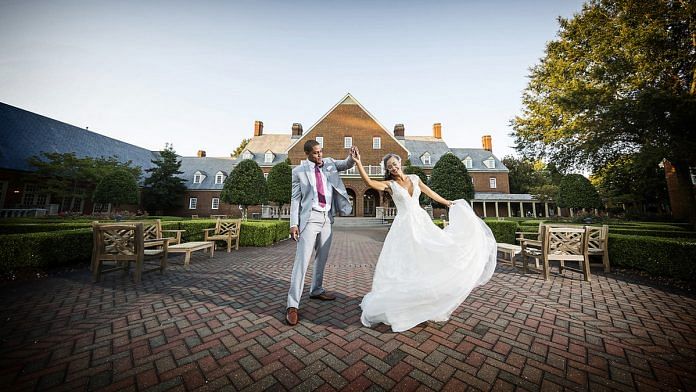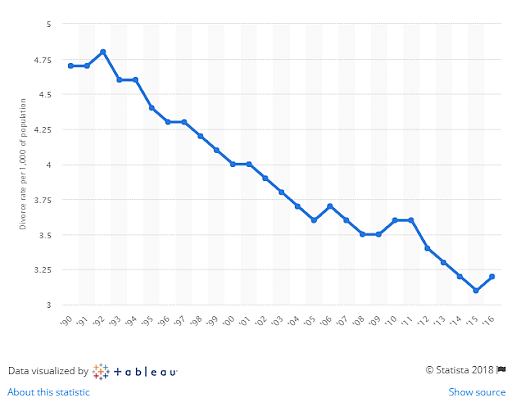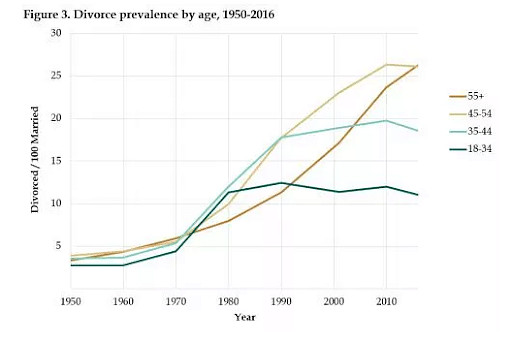Unlike baby boomers, millennials prefer marrying once they have completed their education, established their careers and accumulated sound finances.
Young people in the United States are rebelling against their parents’ generation, though not in a way that you might expect.
New research suggests Americans in their late 20s have a less than 50% chance of getting divorced. Meanwhile, their chances of staying married are increasing.
Divorce rate in US 1990-2016 (per 1,000 of population)
As the chart shows, the US divorce rate began falling in the early 1990s and has since continued on an overall downward trend. In 1992, there were 4.8 divorces per 1,000 population. By 2016, this had dropped to 3.2.
The falling divorce rate may have a lot to do with millennials’ attitudes to marriage. Analysis of American Community Survey (ACS) data by Philip Cohen, a sociology professor at the University of Maryland, suggests young people are doing things differently to previous generations.
Unlike baby boomers who married young regardless of their circumstances, millennials – and some Gen Xers – are choosing to marry once they have completed their education, have established their careers and have sound finances.
Cohen notes that both marriage and divorce rates are dropping. And as the divorce rate is calculated as a percentage of marriages, the 18% fall in divorces between 2008 (when ACS began collecting data) and 2016 isn’t merely a consequence of fewer marriages. The implication is that contemporary unions are lasting longer than those of 10 years ago.
Breaking with the past
The trend for the boomer generation to marry, divorce, then repeat the pattern sometimes into their 60s and 70s, caused unusually high rates of marriage breakdown, Cohen says. Although the rate of “grey divorce” has stabilized in the past decade, it is still far higher than for previous generations at the same age.
Millennials are making better marriage choices than previous generations, according to Cohen. He explains that “many of the people getting married today are more privileged than they used to be: more highly educated (both partners), and socially and economically stable, all of which bodes well for the survival of their marriages (even if it means more inequality in society)”.
Alongside the falling marriage rate is a rise in cohabiting couples. Increasingly, American couples are opting to live together before marriage, or choosing not to tie the knot at all.
Research suggests that modern cohabiting relationships are less stable than they used to be.
Cohen points out that many American couples from poor and less educated backgrounds are living together and choosing not to marry.
Those who do tie the knot tend to be older, better off and more highly educated. “Marriage is more and more an achievement of status, rather than something that people do regardless of how they’re doing,” he told Bloomberg.
A downward trend
Across the Atlantic, a similar trend is occurring in England and Wales, where the divorce rate increased year-on-year from 2000 to 2004 before falling in a similar fashion to that of the US.
The UK’s Office for National Statistics states that divorce rates for opposite-sex couples – which peaked in 1993 – are now at their lowest since 1973. But the divorce rate for older people is heading in the opposite direction and was higher in 2017 than the previous 1993 peak.
Marriage rates among older people have increased in recent years, but are falling among young couples. Men and women aged 45-49 are the age group statistically most likely to divorce in England and Wales.
As in the US, more young people in England and Wales are saying “I don’t” to marriage and the couples that marry are saying “I do” later in life.
Johnny Wood is a senior writer at Formative Content.
This article was originally published on The World Economic Forum’s website. Read the original article here.








